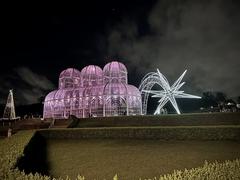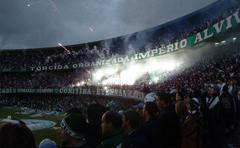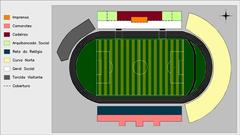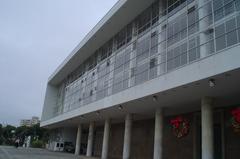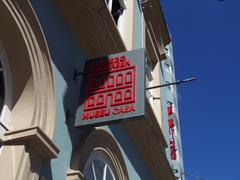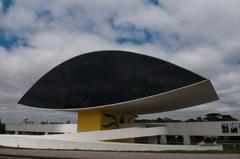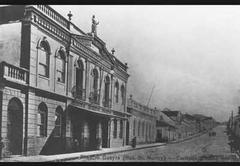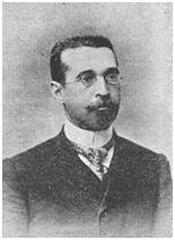
Teatro Paiol: Visiting Hours, Tickets, and Guide to Curitiba’s Historic Landmark
Date: 04/07/2025
Introduction
Teatro Paiol, located in the heart of Curitiba, is a celebrated cultural landmark that unites history, distinctive architecture, and a rich artistic program. Originally built in 1874 as a gunpowder depot for the Brazilian Army, its transformation into a theater in 1971 marked a milestone in Curitiba’s urban revitalization and cultural policy. Today, Teatro Paiol stands as an icon of adaptive reuse, offering visitors an immersive journey through Curitiba’s past and present.
This detailed guide provides everything you need to know about Teatro Paiol—its origins, architectural features, visiting hours, ticketing, accessibility, special events, guided tours, and nearby attractions. Whether you are a history enthusiast, an architecture lover, or a cultural explorer, Teatro Paiol is a must-visit among Curitiba historical sites.
For the latest information, visit the official website of the Fundação Cultural de Curitiba (Fundação Cultural de Curitiba) and explore the dedicated Teatro Paiol page (Turistoria; Encontra Curitiba).
Table of Contents
- History and Transformation
- Architectural Features and Preservation
- Cultural Significance and Programming
- Visiting Hours, Tickets, and Accessibility
- Special Events and Guided Tours
- Nearby Attractions and Travel Tips
- Frequently Asked Questions (FAQ)
- Visual Resources and Interactive Features
- Key Visitor Tips and Summary
- Sources and Official Links
History and Transformation
Origins as a Gunpowder Depot
Teatro Paiol’s building was constructed in 1874 during the reign of Dom Pedro II to serve as a gunpowder storage facility for the Brazilian Army. Its location, then on the outskirts of Curitiba, was chosen for security reasons, keeping explosives away from residential areas (Wikipedia; Turistoria). Designed in a circular, Roman-inspired style, the thick brick walls and minimal windows maximized safety and resilience (Arquivo Arquitetura).
From Military Use to Cultural Renewal
As Curitiba grew and urbanized, the depot’s proximity to new neighborhoods made it unsuitable for storing explosives. By the early 20th century, the building was repurposed for less hazardous uses, including municipal archives and the city’s pavement works department. Decades of underuse and neglect followed, but the robust construction ensured its survival (Curitiba Histórica).
Transformation into a Theater
The turning point came in the 1970s under Mayor Jaime Lerner. Architect Abrão Assad was tasked with converting the historic structure into a modern cultural venue, preserving its military heritage while adapting it for the performing arts (Paraná Entretenimento). The original circular plan was retained, and the space was reimagined as an arena theater, accommodating around 217–225 spectators (Arquivo Arquitetura).
The official inauguration took place on December 27, 1971, with a landmark performance featuring Vinícius de Moraes, Toquinho, Marília Medalha, and Trio Mocotó. The event was pivotal for Curitiba’s cultural scene and inspired the creation of the Fundação Cultural de Curitiba (Turistoria).
Architectural Features and Preservation
Teatro Paiol is a prime example of adaptive reuse in Brazilian architecture (Encontra Curitiba). The circular design, thick masonry walls, and small, high-set windows are remnants of its military past. The building’s austere exterior is complemented by a low-pitched domed roof, while the interior’s arena configuration fosters intimacy and excellent acoustics (EAA).
Key architectural highlights:
- Original brickwork and fortress-like walls: Provide both structural strength and acoustic excellence.
- Arena-style seating: Ensures every attendee enjoys clear sightlines and sound.
- Minimalist restoration: New materials and seating were chosen to harmonize with historic features.
- Symbolic elements: The building’s transformation is a visual metaphor for Curitiba’s evolution from a military outpost to a cultural capital.
Preservation efforts have kept the structure’s historical integrity intact while updating accessibility features and audience comfort (Arquivo Arquitetura).
Cultural Significance and Programming
A Hub for Creative Expression
Since its inauguration, Teatro Paiol has played a vital role in Curitiba’s cultural life. Its stage has hosted legends like Hermeto Paschoal, Elza Soares, Gal Costa, Raul Seixas, and many others (Turistoria). The theater’s programming spans music, theater, festivals, and innovative series such as:
- “Brasis no Paiol” (since 2012): A platform for independent Brazilian artists across genres, with over 150 shows (Bem Paraná; Divirta-se Curitiba).
- “Parcerias Impossíveis”: A dialogue series uniting artists, politicians, and thought leaders.
- Community workshops and artist talks: Fostering engagement and cultural education.
The venue’s circular layout creates a unique connection between performers and audience, making each event a memorable experience.
Visiting Hours, Tickets, and Accessibility
- Visiting Hours: Tuesday to Sunday, typically from 2:00 PM to 10:00 PM. Exact hours depend on scheduled performances. Always check the latest programming online (Fundação Cultural de Curitiba).
- Tickets: Prices range from R$20 to R$50, with discounts for students, seniors, and people with disabilities. Tickets can be purchased online or at the box office. Advance purchase is highly recommended for popular events.
- Accessibility: Teatro Paiol is fully accessible, with ramps, adapted restrooms, and designated seating. Staff are available to assist visitors with special needs.
Special Events and Guided Tours
Teatro Paiol offers guided tours by appointment, providing visitors with insights into its history, architecture, and cultural impact. Special events include:
- Themed nights and festivals
- Community workshops
- Artist residencies and talks
For up-to-date schedules and tour availability, refer to the official website or social media channels.
Nearby Attractions and Travel Tips
Located at Praça Guido Viaro in central Curitiba, Teatro Paiol is easily accessible by public transport, car, or even walking from the city center. Nearby attractions include:
- Oscar Niemeyer Museum
- Curitiba Historical Centre
- Rua 24 Horas pedestrian street
- Municipal Market
Combine your theater visit with meals at local restaurants or a stroll through Curitiba’s historic districts (Mapcarta; Adventure Backpack).
Frequently Asked Questions (FAQ)
What are Teatro Paiol’s opening hours?
Tuesday to Sunday, usually from 2:00 PM to 10:00 PM, depending on the event schedule.
How do I buy tickets?
Purchase online via the official site or at the theater’s box office.
Is Teatro Paiol accessible?
Yes, the theater is wheelchair accessible and offers adapted facilities.
Are guided tours available?
Yes, by appointment. Visit the website for details.
What else can I visit nearby?
Oscar Niemeyer Museum, Curitiba Historical Centre, Rua 24 Horas, and the Municipal Market are all close by.
Visual Resources and Interactive Features
- Photo galleries and virtual tours are available on the official website and social media, providing visuals of the theater’s exterior and interior.
- Interactive maps help visitors plan their route and explore nearby attractions.
- Alt tags for images: e.g., “Teatro Paiol exterior circular façade,” “Interior arena seating at Teatro Paiol,” “Teatro Paiol visiting hours.”
Key Visitor Tips and Summary
- Buy tickets in advance—seating is limited, and popular events sell out quickly.
- Arrive early to enjoy the ambiance and architecture.
- Check the weather—Curitiba’s climate can be unpredictable.
- Respect venue etiquette—silence devices and avoid photography during performances unless permitted.
- Engage with the community—participate in discussions and workshops for a richer experience.
Teatro Paiol exemplifies Curitiba’s commitment to cultural preservation and innovation, making it a must-see for visitors seeking authentic local experiences.
Sources and Official Links
- Teatro Paiol: História, Cultura e Guia Completo para Visitantes em Curitiba, 2024, Turistoria
- Teatro Paiol, Wikipedia, 2024
- Teatro Paiol: Arquitetura e História, 2024, Arquivo Arquitetura
- Exploração da História e Magia do Teatro Paiol, 2024, Paraná Entretenimento
- Projeto Brasis no Paiol divulga programação, 2025, Bem Paraná
- Projeto Brasis no Paiol, 2025, Divirta-se Curitiba
- Teatro Paiol Curitiba, Encontra Curitiba, 2024
- Descubra o Projeto da Visibilidade e Artistas de Diversas Regiões do País, 2025, Fringe
- Projeto Brasis Agenda 2025, Pra Conhecer Melhor
- Adventure Backpack: Curitiba Nightlife
- Mapcarta: Teatro Paiol Location
- DoinBrazil: Curitiba Guide
- EAA: Best Architectural Buildings in Curitiba
Plan your visit to Teatro Paiol and experience the heart of Curitiba’s cultural and historical heritage. For up-to-date event listings and tickets, download the Audiala app and follow the Fundação Cultural de Curitiba on social media.





